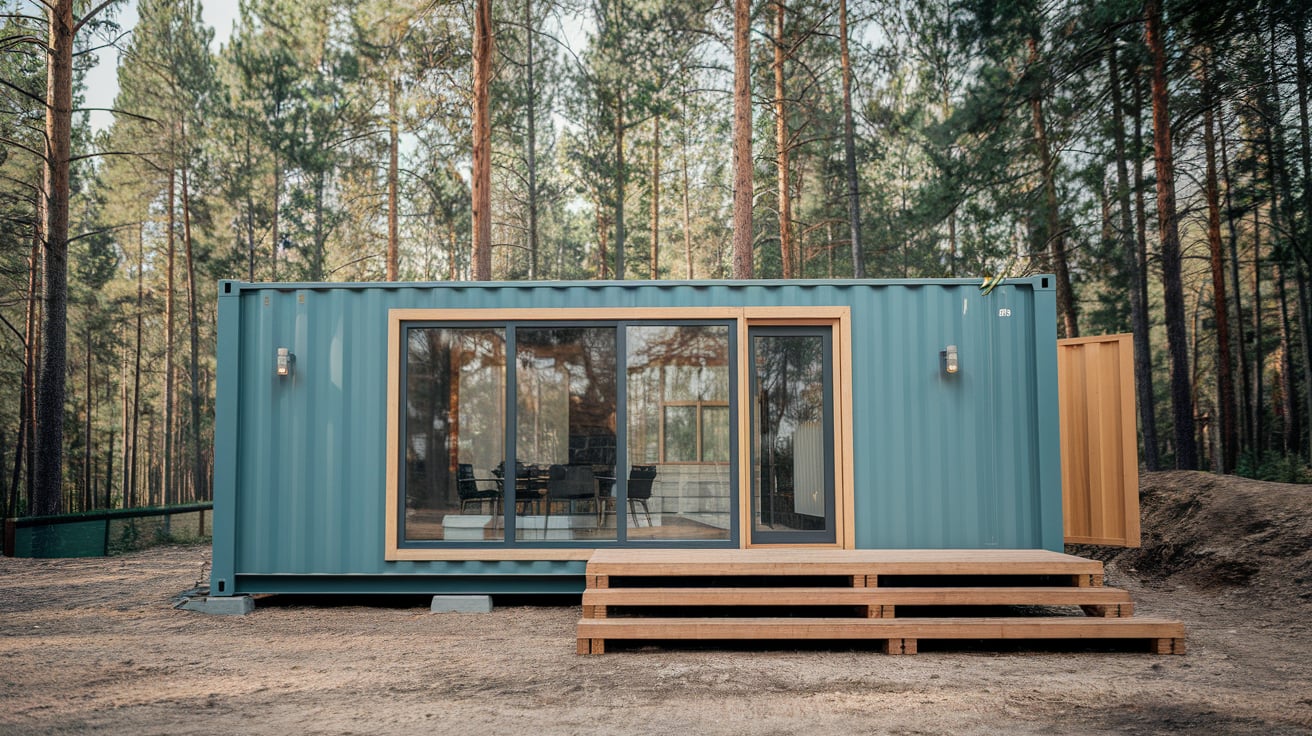Want to build a home that stands out? Container homes offer a smart choice for people looking for affordable living. These homes use shipping containers as their base structure, giving you a strong foundation to work with.
The key to a good container home is letting in natural light, which can make a small space feel bigger. When you build one, you can add glass doors with blinds for both light and privacy.
This gives you the freedom to enjoy your space without prying eyes.
Container homes also let you connect with nature while keeping all the comforts of a regular.
Why Choose a Container Home?
Container homes have gained attention in recent years as a housing option. They cost less than normal homes and can be built faster. You can make them as simple or fancy as you like, based on your budget and needs.
These homes are also good for the earth. Reusing shipping containers helps reduce waste. Each container you use is one less sitting unused in a port or yard.
Container homes can go almost anywhere. You can put them on open land, in the woods, or even stack them for a multi-level home. Their strength makes them a good choice for areas with tough weather.
Another plus of container homes is how quick they are to build. Since the main structure already exists, you can focus on making the inside nice. This means less time waiting and more time living in your new space.
Step-by-Step Guide to Building Your Container Home
Tools and Materials Needed to Build a Container Home
| Tools | Materials |
|---|---|
| Welding equipment | Shipping container(s) |
| Power drill and bits | Insulation materials |
| Angle grinder | Drywall or wall panels |
| Measuring tape | Flooring materials |
| Level | Windows and doors |
| Safety gear (gloves, goggles, helmet) | Plumbing supplies |
| Jigsaw or plasma cutter | Electrical wiring and outlets |
| Hammer | Paint or exterior coating |
| Screwdrivers | Roofing materials |
Step 1: Find and Purchase Your Container
Start by looking for shipping containers in good condition. Check local ports, container yards, or online marketplaces. Look for containers without major dents, rust, or structural issues.
Standard sizes are 20 or 40 feet long. Newer containers cost more but have fewer problems. If possible, always inspect in person before buying. Check the container number to learn its history. Make sure the doors work properly and close tightly.
Once purchased, arrange for delivery to your building site. Remember that you’ll need special equipment to unload and position the container.
Step 2: Prepare Your Building Site
Choose a flat area for your container home. Clear away plants, rocks, and other items from the spot. Make sure the ground can hold your container’s weight. Depending on local rules, you might need a concrete slab or foundation blocks.
Check with town officials about permits before starting any work. Mark the exact spot where your container will sit using stakes and string. When placing your home, consider how the sun moves across your land.
Think about where to connect water and power lines. Good site prep makes the rest of the build much easier.
Step 3: Create Your Floor Plan
Draw a simple floor plan showing where the walls, doors, and windows will go. Think about how you’ll use each space in your home. Plan for bathroom and kitchen areas near water hookups.
Mark where you want to cut openings in the container walls. When planning large openings, consider the container’s strength. Leave some solid sections to maintain structure. Plan for heating and cooling needs in your design.
Include spaces for storage since container homes can feel small. Your floor plan doesn’t need to be fancy, but it should be clear. Measure twice before making any cuts to your container.
Step 4: Cut Openings for Windows and Doors
Using your floor plan as a guide, mark where you’ll cut doors and windows. Start by drawing outlines with chalk or marker. Use a level to ensure the lines are straight. Wear safety gear before cutting through metal.
A plasma cutter works best, but an angle grinder can work, too. Cut from inside the container when possible to control sparks. Make cuts slightly smaller than your windows and doors. This gives you room to frame the openings properly.
Smooth all cut edges to remove sharp points. Be careful not to cut structural corner posts. If you need a large opening, add support beams above the cut.
Step 5: Install Windows and Doors
After cutting openings, install frames for windows and doors. Use weather-resistant frames that can be sealed well. Position each frame in its opening and check that it’s level—secure frames with screws or by welding them in place.
Adding proper flashing prevents water leaks around openings. Install your windows, making sure they open and close easily. Choose doors that offer good security and insulation. Test all windows and doors after installation.
Apply sealant around frames to prevent air and water leaks.
Step 6: Add Insulation and Interior Walls
Insulation is crucial for container homes to control temperature. Start by cleaning the inside of your container thoroughly. Apply a moisture barrier to prevent condensation issues. Install foam board or spray foam insulation on walls, ceilings, and floors.
Cover insulation with studs to create a frame for interior walls. Leave space for electrical wiring and plumbing. Install drywall or paneling over the framing. Tape and mud drywall seams for a smooth finish. Prime and paint your walls in light colors to make spaces feel bigger.
Consider using space-saving wall systems where possible. Good insulation makes your container home comfortable all year.
Step 7: Install Electrical and Plumbing Systems
Plan your electrical system with enough outlets and lighting. If you’re not confident with wiring, hire a licensed electrician. Run electrical cables through the conduit attached to the container walls.
Install a breaker box and connect to local power. For plumbing, place pipes during the wall-framing stage. Keep bathroom and kitchen areas close to reduce pipe length. Install water-saving fixtures to keep usage low.
Consider composting toilets if water access is limited. Test all systems before closing up walls. Get inspections as required by local building codes. Proper electrical and plumbing work makes your container home safe and functional.
Step 8: Add Finishing Touches and Décor
Once the main building work is done, focus on making your container home feel inviting. Install flooring that suits your style and budget. Add trim around windows, doors, and where walls meet ceilings.
Paint interior walls with washable, light-colored paint. Consider built-in furniture to save space in your small home. Install countertops and cabinets in the kitchen area. Add shelving and storage solutions where possible.
Hang curtains or blinds for privacy and light control. Bring in plants to add life to your space. Choose multi-purpose furniture that can serve different needs. These small details turn your container into a true home.
Step 9: Set Up Outdoor Areas
Create outdoor living spaces to extend your small container home. Build a simple deck or patio area connected to your home. Add outdoor seating where you can enjoy nature.
Consider a pergola or awning for shade during hot days. Plant native plants that need little care around your home. Create pathways connecting different outdoor areas. Add outdoor lighting for evening use of your space.
Build raised garden beds if you want to grow food. Consider a fire pit for cooler evenings outdoors. These outdoor areas make your container home feel much bigger than it is. They help you connect with the natural world around your new home.
Video Tutorial
Check out this YouTube video for a detailed step-by-step Tutorial on container home.
The Reality & Challenges of DIY
- It’s NOT Always Cheaper: Hidden costs (permits, specialized tools, unexpected repairs, needing professional help for certain tasks like electrical/plumbing) can add up quickly. Mistakes are costly.
- Steep Learning Curve: You need knowledge in design, structural engineering principles, welding, framing, insulation, plumbing, electrical, HVAC, finishing, and project management.
- Intense Labor & Time: This is a massive time commitment and is physically demanding. It’s not a weekend project.
- Permitting and zoning Hurdles are often the biggest obstacles. Many municipalities have strict codes, and container homes might not fit neatly into existing regulations. Getting approvals can be difficult and time-consuming.
- Structural Integrity: Cutting holes for windows and doors weakens the container’s structure. Reinforcement is crucial and requires engineering knowledge or consultation.
- Insulation & Condensation: Metal containers conduct heat and cold extremely well. Proper insulation (often spray foam for best results, which can be expensive or tricky DIY) and vapor barriers are critical to prevent condensation (leading to rust and mold) and ensure comfort.
- Finding Suitable Containers: Not all used containers are equal. You need “one-trip” or gently used containers without significant dents, rust, or potential chemical contamination from previous cargo.
Things to Avoid When Building a Container Home
| MISTAKES to AVOID | WHY It’S a PROBLEM | BETTER ALTERNATIVE |
|---|---|---|
| Cutting too much metal | Weakens the structure | Limit large cuts and add support beams |
| Skipping proper insulation | Makes home too hot/cold | Use high-quality foam insulation |
| Ignoring local building codes | Can lead to fines or rebuilding | Research permits before starting |
| Poor site preparation | Causes uneven settling | Create a proper foundation first |
| Using standard house materials | Not made for metal homes | Use materials made for metal structures |
| DIY electrical without knowledge | Safety hazard | Hire a professional for complex systems |
| Inadequate ventilation | Leads to moisture problems | Install proper air flow systems |
| Using the wrong paint/coatings | Premature rusting | Use marine-grade products |
| Forgetting about condensation | Mold and rust inside walls | Install vapor barriers |
| Not planning for utilities | Difficult retrofitting | Plan all systems before building |
Conclusion
Building your own container home takes work but brings great rewards. With careful planning and the right approach, you can create a unique living space that fits your needs.
Proper insulation, letting in natural light, and keeping moisture out are the most important things to remember. These three factors make the difference between a comfortable home and a metal box.
Container homes give you the chance to build without spending too much money. They also let you live with less impact on the earth. By following the steps in this guide, you can turn simple shipping containers into a cozy, personal space.
Remember that your container home should reflect what matters to you. Whether that’s open space, lots of windows, or strong ties to the outdoors, you can build it your way.
Take your time with each step of the process, and ask for help when needed. The result will be a home that truly belongs to you—both in ownership and spirit.
Frequently Asked Questions
1. How Much Does a Container Home Cost to Build?
Container homes typically cost between $10,000 and $35,000 for a basic build, depending on size and features.
2. Do Container Homes Need Special Permits?
Yes, most areas require building permits, zoning approval, and inspections, just like regular homes.
3. How Long Do Container Homes Last?
With proper care and protection from rust, container homes can last 25 years or more.
4. Can Container Homes Withstand Harsh Weather?
Shipping containers are built to handle ocean travel, making them very strong against wind, rain, and snow when properly secured.

















